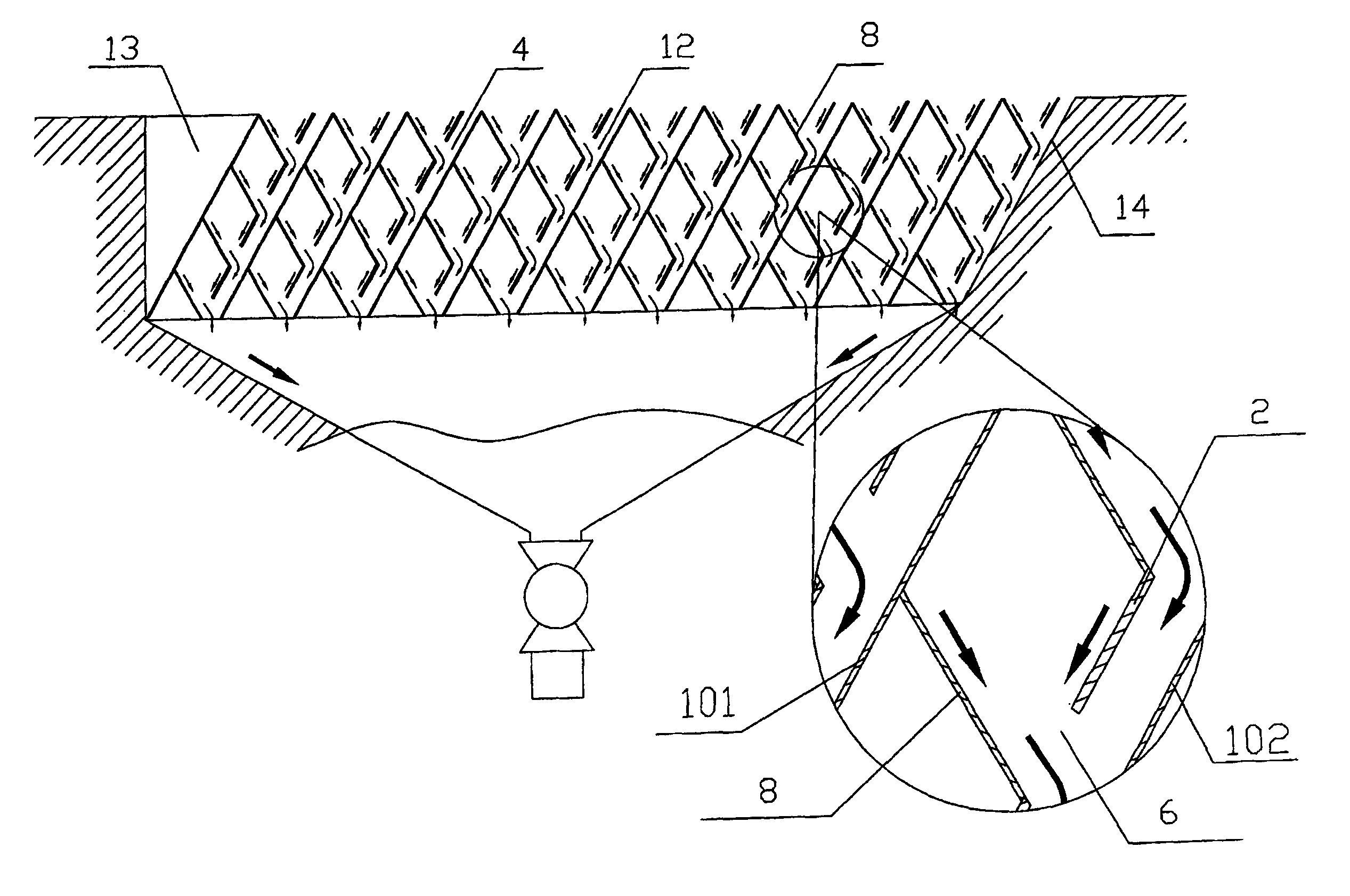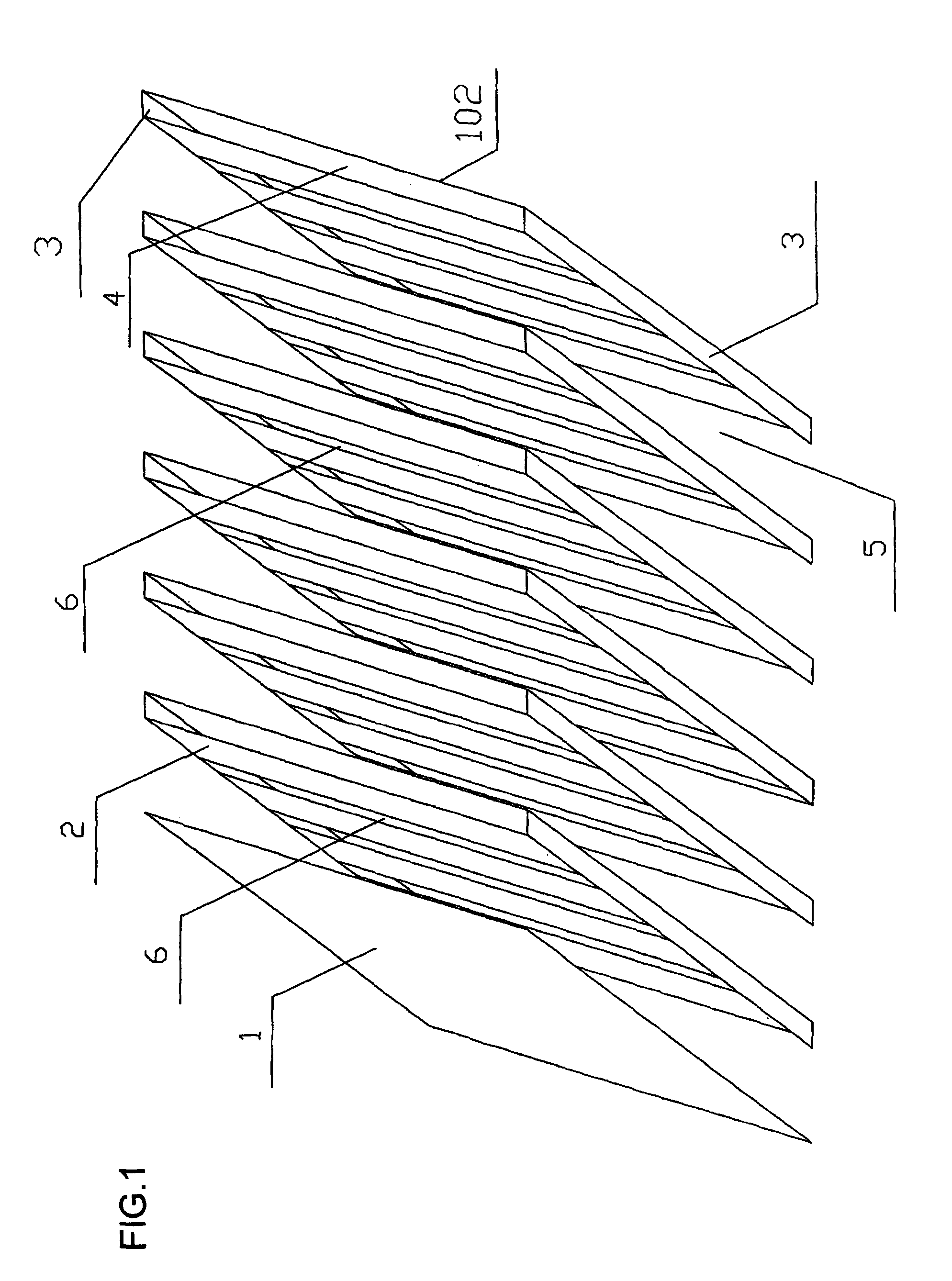Horizontal-tube sedimentation-separation apparatus
a sedimentation-separation apparatus and horizontal tube technology, applied in sedimentation settling tanks, separation processes, liquid displacement, etc., can solve the problems of reversible sedimentation, water state variation, harmful suspension sedimentation, etc., and achieve the effect of gradual decrease of width
- Summary
- Abstract
- Description
- Claims
- Application Information
AI Technical Summary
Benefits of technology
Problems solved by technology
Method used
Image
Examples
first embodiment
[0034] As described in FIG. 1, this horizontal-tube sedimentation-separation apparatus incorporates multiple parallel inclined plates 1, and between adjacent inclined plates 1 are isolated plates 2 which are parallel to inclined plate. Baffles 3 that are vertical to the water flowing direction are set in front of and back of the bottom of isolated plate 2, which blocks water flowing under the isolated plate 2, thereby forming a static fluid region 4. The static fluid region 4 together with the flowing region 5 up the isolated plate forms a working unit. Multiple sludge-disposal paths are set on isolated plate 2 from top to bottom, and each of them is designed as a long-tank 6 extended in the direction of water flow.
second embodiment
[0035] As described in FIG. 2, each line of sludge-disposal path consists of multiple sludge-disposal ports 7 distributed along the direction of water flow. Other components and structures are the same as described in first embodiment.
[0036]Third embodiment: As described in FIG. 3, there are four pieces of baffle 3. Other components and structures are the same as described in first embodiment. The front and back baffles tightly connect with isolated plate and lower inclined plate, thus forming static fluid region. Intermediate baffle plays a supporting and reinforcing role to prevent deformation of and the closing between isolated plate and lower inclined plate.
fourth embodiment
[0037] As described in FIG. 4 and FIG. 5, between isolated plate 2 and its upper inclined plate 101 is the flat supporting plate 8, whose upper end connects with upper inclined plate 101 and its lower end connects with and also flush with the bottom margin of long-tank 6. Other components and structures are the same as described in first embodiment.
[0038]The sludge-disposal path is designed as a long-tank 6 that extended in the direction of water flow. The flat supporting plate 8 is of a complete rectangle shape. The sludge-disposal path is designed as a long-tank 6 that extended in the direction of water flow, and each long-tank requires a complete and rectangle flat supporting plate 8 to match as described in FIG. 4.
[0039]Fifth embodiment: As described in FIG. 5, the sludge-disposal path consists of multiple sludge-disposal ports 7 distributed in the direction of water flow. Each sludge-disposal port 7 requires a piece of flat supporting plate 8 to match, thus the sedimentation wo...
PUM
| Property | Measurement | Unit |
|---|---|---|
| Angle | aaaaa | aaaaa |
| Width | aaaaa | aaaaa |
Abstract
Description
Claims
Application Information
 Login to View More
Login to View More - R&D
- Intellectual Property
- Life Sciences
- Materials
- Tech Scout
- Unparalleled Data Quality
- Higher Quality Content
- 60% Fewer Hallucinations
Browse by: Latest US Patents, China's latest patents, Technical Efficacy Thesaurus, Application Domain, Technology Topic, Popular Technical Reports.
© 2025 PatSnap. All rights reserved.Legal|Privacy policy|Modern Slavery Act Transparency Statement|Sitemap|About US| Contact US: help@patsnap.com



